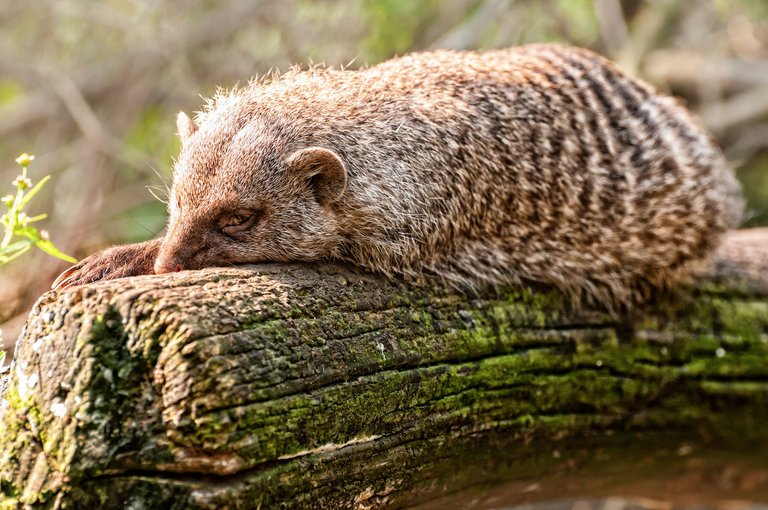NO I Will Not Look Look At You!
Be sure to click on the image to view full screen!
| Category | Animalphotography |
| Settings | ISO 800, f6.3, s 1/200, 180mm |
| Camera | NIKON D300s |
| Lens | 70.0-300.0 f4.5-f5.6 |
| Location | ZieZoo Volkel, Noord Brabant, The Netherlands |
In a little zoo in Volkel, North Brabant, The Netherlands you can find this cute animal. The Zebra Mongoose. The zebra mongoose is a small predator, related to the meerkat. It occurs on the African savanna and has its name through the striped drawing on the back. An adult animal is 55 to 60 centimeters long and 1.5 to 2.25 kilograms heavy. The tail is 15 to 30 centimeters long. The species is especially common in areas with many termite mounds, which serve as a residence. The zebra mongoose is found in a large part of Africa. The zebra mongoose is active during the day, but in extreme heat only in the morning and in the evening. It is a group animal that lives together in stable family groups of about 30 species. If a group contains more than 40 animals, it will usually split into two smaller groups of 15 to 20 animals. Members of a group can recognize each other by a joint group odor.
Zebramongoos use abandoned termite hills as their daily stay. The hills, which have a size of about 1 m³, are decorated by mongooses with all kinds of rooms. The territory can be quite large, up to 130 hectares. It is delineated with fragrance flags. Especially high-ranking males mark the territory regularly. Striking places in the territory, including termite hills, stones and tree stumps, are marked daily.
The food consists mainly of insects, lizards, snakes, frogs and often also mice. He digs up much of his food with the sharp claws. Sometimes he also eats plant roots and fruits. A popular snack is a bird's egg. These are stolen from the nest with the front legs and then dragged away between the hind legs. The zebra mongoose usually forages in small, separate subgroups. During the foraging, the zebra mongoose is regularly on his hind legs to explore the area. He keeps in contact with the other group members with a wide variety of sounds.

Nice shot and info.
Je zou zeggen dat Nederland toch te koud is voor die Afrikaanse beesies.
Dat is wat ik me ook vaak afvraag hoor ... wat doen ze die beessies aan? Kunnen die beessies wel goed tegen ons klimaat? Hebben ze het niet veel te koud? Of zijn de afrikaanse nachten ook soms koud? Ik zou vaak willen dat ik gedachten kon lezen ...
Here are a few of them at a camp we stayed in in South Africa this past weekend. They're scavenging but are still pretty cute!
Ahw that's much better seeing them in the wild ...
World of Photography Beta V1.0
>Learn more here<
You have earned 6.00 XP for sharing your photo!
Daily photos: 1/2
Daily comments: 0/5
Multiplier: 1.20
Server time: 13:53:58
Total XP: 1251.55/1600.00
Total Photos: 48
Total comments: 14
Total contest wins: 21
Follow:
Join the Discord channel: click!
Play and win SBD:
Daily Steem Statistics:
Learn how to program Steem-Python applications:
Developed and sponsored by:Thank you for participating in #animalphotography @photocontests@fairlotto@dailysteemreport@steempytutorials @juliank
Awwwwww so beautiful ♥️♥️♥️